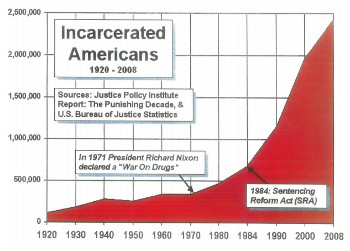Notice: Undefined variable: dots in /var/www/vhosts/thejusticeimperative.org/httpdocs/wp-content/plugins/easy-twitter-button/tweet.php on line 328
Executive Summary
 As documented in Michelle Alexander’s groundbreaking book “The New Jim Crow: Mass Incarceration in the Age of Colorblindness,” the war on drugs has been waged over the past four decades with equal vigor by both Democratic and Republican administrations. Such war was accompanied by stricter sentencing policies (e.g., three-strikes laws, truth in sentencing and mandatory minimums) and less use of probation and parole.
As documented in Michelle Alexander’s groundbreaking book “The New Jim Crow: Mass Incarceration in the Age of Colorblindness,” the war on drugs has been waged over the past four decades with equal vigor by both Democratic and Republican administrations. Such war was accompanied by stricter sentencing policies (e.g., three-strikes laws, truth in sentencing and mandatory minimums) and less use of probation and parole.
Between 1980 and 2000, the number of people incarcerated in the U.S. rose almost 700 percent from 300,000 to over 2 million. By 2008, more than 7 million Americans (1 out of every 31 adults) were estimated to be behind bars, on probation or on parole. In 2008, one in every 48 working-age men was in prison or jail, compared with one in 153 in 1960 and one in 156 in 1980. This explosion in the number of prisoners is attributed in major part to the war on drugs and the resulting surge in drug convictions. The irony is that the war on drugs took root at a time when illegal drug use in the U.S. was actually on the decline.






